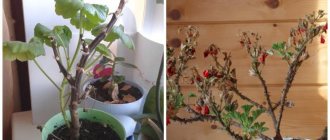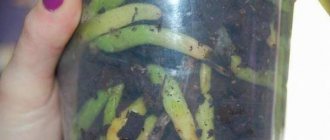How to determine that a flower is sick?
The leaves of the dendrobium have begun to turn yellow - this is the first sign that the plant is not being cared for correctly. In this case , such a phenomenon as curling of leaves and yellowing of the stem often occurs . It is not difficult to determine that an orchid has begun to get sick, since a change in the color of the leaves is immediately visible.
Important! If the leaves turn yellow, the flower needs to be saved, but to do this, it is important to determine why the plant began to hurt. And to prevent this situation from happening again, you need to know the reasons why the orchid begins to turn yellow.
Main reasons
There are several of the most common causes of yellowing of dendrobium leaves - high temperature, disturbance or rotting of roots, low air humidity, overfeeding. There is no need to panic if the leaves turn yellow and begin to fall off after flowering, since this is a natural phenomenon for the Dendrobium Nobile orchid, but if this happened before or during flowering, then you should pay close attention to this.
Despite the fact, growing an orchid is a troublesome task, but in gratitude you can get a magnificent flower with unusual buds. It is worth knowing that each individual type of orchid has its own characteristics in care .
There are six groups into which dendrobiums are divided, and each has specific requirements for indoor air temperature. Therefore, to avoid yellowing of the foliage, you need to create an optimal room temperature for the plant. There are dendrobiums that are heat-loving, and there are those that need to be kept in a cool environment.
For heat-loving varieties, the temperature considered comfortable is:
- period of active development and growth during the day +20-25 degrees;
- at night 16-21 degrees plus;
- during the rest period - in winter, during the day no more than +20 degrees;
- at night no less than +18.
Cool-loving plants:
- in summer, daytime 16-18°C;
- at night about 12°C;
- on winter days about 12°C;
- winter nights 8°C.
The leaves may turn yellow due to rotting of the roots . As is known in nature, orchids live on tree trunks, so the root system of the flower is free from soil. Even after heavy rains they dry very quickly. Therefore, at home, you should avoid dampness in the substrate. Sometimes the cause of yellowing is the age of the plant.
Even if the orchid was purchased recently, there is no guarantee that it has not been in the store for a long time. Despite the fact that dendrobium is a tropical plant, it does not tolerate direct sunlight. On hot sunny days, the orchid needs to be shaded, otherwise a burn may appear on the leaves and they will turn yellow.
Pests and insects cause diseases and yellowing of foliage. An orchid can be attacked by thrips, aphids, and slugs, which can grow not only on the stem, but also on the roots.
Important! Lack of moisture also causes yellowing of foliage. Orchid requires timely and stable watering.
Black spots on leaves
If black or brown spots appear on the leaves or pseudobulbs, surrounded by a yellowish rim , then the plant is probably affected by bacterial spotting. This is an infectious disease caused by the microorganisms Pseudomonas cattleyae.
An orchid can become infected with a virus through open wounds or stomata. In favorable conditions, which is a greenhouse climate and temperatures ranging from +25 to +30⁰С, bacteria multiply extremely actively and can infect all the greenery of an orchid literally within a day.
Foci of spread appear on the tips of leaves and lobar veins. They are very easy to recognize by eye based on the signs described above, so there is no need to resort to laboratory tests. Bacteria spread through the wind, through insects, contaminated substrate or with irrigation water.
How to help an orchid
The disease and its course are quite unpleasant for the flower, but the problem can be solved simply and quickly. The bacteria are extremely active in the first days, but after development they are greatly inhibited and growth in the greenery occurs sluggishly and reluctantly. In a month, spots can increase by half a centimeter at most.
After detecting obvious signs of disease, the orchid must be isolated from other plants to prevent a local epidemic. The affected areas need to be cut out and the wounds treated with crushed activated carbon or iodine.
You can resort to antibiotics only in the most advanced cases. If there are not many spots, then there is no need to load the flower with unnecessary chemicals.
After 7-10 days, the disease should subside and the orchid can be returned to its place with the rest of the flowers. It is also worth noting that the main breeding ground for such bacteria is water. If bacterial spot appears on all plants at once, then it is best to send the irrigation liquid for laboratory analysis.
Why are changes happening?
Most of them are associated with improper care of the crop, so to maintain the health of the plant, you need to determine exactly what caused the pathology and review the rules for caring for the flower. There are five common situations in which leaves change color.
Aging
Often an orchid begins to bloom only 2-3 years after planting , by which time the plant has already formed true leaves. The aging process begins to affect the lower part of the plant, that is, those leaves that grew first. At the same time, the flower itself is in a healthy condition and has an attractive appearance and continues to bloom. If the leaves turn yellow during the aging process, then there is no need to worry and do something, the leaf will gradually dry out and fall off.
Excess moisture
Proper watering involves placing the plant pot in a bowl of water. In this case, the pot should be 1/3 immersed in water. Leave the plant in this position for 15 minutes, otherwise the soil will become waterlogged.
If watering is excessive, the following happens: the substrate becomes saturated with moisture and becomes impermeable to air, and the root system begins to become oxygen starved. The result is insufficient nutrition of the flower itself, causing the leaves to begin to turn yellow. It is also worth considering that bacteria and fungi can develop in a moist substrate , which provoke plant disease.
Insufficient watering
Orchid leaves can also turn yellow from lack of moisture; they gradually wither, curl and dry out. It is worth noting that this is a very rare occurrence - usually housewives water the flowers as soon as the top layer of soil dries out. Therefore, before watering the orchid again, make sure that the cause of yellowing is precisely the lack of water. To do this, just take a few pieces of bark from the substrate and evaluate the moisture content. You can also just pick up the pot - if it is light, then the soil is dry.
Sunburn
Often, improper lighting causes yellowing of foliage - this is sunburn. If the plant stands on a western or southern window, then in the summer it will receive direct sunlight, which burns the plates. A distinctive feature of this phenomenon is that not the entire leaf plate turns yellow, but only part of it. You should not remove damaged parts - they can recover or fall off on their own; in extreme cases, you can perform sanitary pruning.
Insects
The ground part of the orchid is very delicate, so various insects and pests often grow on it, which subsequently cause yellowing of the leaf plates.
pests: Let's look at the most common
- Spider mite , which sucks the sap from the plant, causing small yellow dots and thin webs to appear on the stems and leaves. If you notice such signs, immediately isolate the diseased plant from other flowers - the mite spreads very quickly. The leaves of a diseased flower should be washed with a solution of laundry soap.
- Aphids - in this case, the leaf not only turns yellow, but also becomes sticky. Aphids can be removed with a soap solution or sprayed with Fitoverm.
- Scale insects are a pest that is very difficult to remove. As soon as you notice growths on the leaves of the plant, you need to take action. You can use folk recipes: a solution of ammonia or a mixture of vegetable oil and water. But the most effective drug for combating scale insects is Actellik.
What causes the yellowing of the stem?
The reasons for this phenomenon can be of a different nature, including:
- Natural aging of the plant;
- Violation of care rules and growing conditions;
- A sharp change in the microclimate after purchasing an orchid;
- Damage by pests or phytopathogenic microorganisms.
If the flower is provided with appropriate care, it will recover over time and the stem will acquire a healthy appearance. So why did the orchid’s stem turn yellow and what are the main reasons?
Malaise or physiological process?
If the leaves and stem of a young orchid turn yellow, then the cause of aging disappears on its own. Further actions should be aimed at establishing the cause of the disease.
The aging of a flower is related to its life cycle. Life expectancy is determined by the type of orchid and can range from 4 to 17 years.
Having ruled out aging as the cause of yellowing of the stem and leaves, the source of the threat must be sought in mistakes made when caring for the orchid.
Mechanical damage
Yellowing may result from falling or damage to part of the plant.
If the wound is not disinfected in time, it can become an entry point for various infections and cause rotting of the stem. With proper care, the injured area will heal and the orchid stem will restore its natural color.
Lack or excess of moisture
Insufficient watering of the orchid is observed much less often than excess moisture. Its symptoms are:
- The stem turns yellow from top to bottom and at the base;
- Yellowing of leaf tips;
- Light roots;
- Lethargy and wrinkling of leaves.
When these signs appear, it is worth assessing the moisture content of the substrate:
- Lift pieces of bark from the top layer of soil;
- Stick a wooden stick into the soil along the wall of the pot and check after a couple of minutes. If it becomes wet, then the substrate is probably waterlogged;
- Weigh the orchid with the pot in your hands; if it is light, then the soil is dry.
A typical mistake of novice gardeners is waterlogging the soil, which is the most common cause of yellowness of the stem and leaves. You can notice it by a number of signs:
- Yellowing affects both the lower and upper leaves, as well as the stem;
- Black spots often appear on the surface of a yellowed leaf blade;
- The roots become dark in color.
Important! A humid environment promotes the appearance of microbial infections that cause root rot.
Often, waterlogging of the soil occurs when the orchid is in the resting phase. During this period, it does not need to be fed and watered frequently; excess moisture accumulates in the soil, which causes:
- Yellowing of the stem and leaves;
- Root rotting;
- Wilting of the plant.
If signs of soil waterlogging appear, you need to assess the condition of the root system and, if necessary, replant the flower.
Sunburn and overheating
Yellowing of an orchid's trunk is often caused by excessive lighting or overheating:
- When the flower is exposed to direct sunlight for a long period;
- Exposed to hot air from an air conditioner;
- Near the location of the orchid there is a heating radiator that is too hot, and the humidity in the apartment is below 50%.
The situation can be corrected by moving the flower to a suitable place, after which the plant will quickly restore its appearance.
Lack of lighting
Orchids grow and bloom well on northern windowsills, but in short daylight conditions they need lighting. Lack of lighting causes yellowing of leaves and stems and slows down the process of photosynthesis.
When there is insufficient light, additional lighting is provided for orchids.
For additional illumination in autumn and winter, use a special phytolamp, which does not harm the plant and does not dry out the air. The lamp should be located at a distance of no closer than 20 cm from the orchid; daylight hours should be extended to 12 hours.
Lack of light is the main factor in the lack of orchid flowering in winter and decreased immunity.
Fungal or bacterial infections
If, despite efforts, it is not possible to restore the color of the stem, the root system may be affected by fungi.
As soon as the disease is discovered, the plant is urgently isolated from other flowers to prevent the spread of infections. After this, a number of recreational activities are carried out:
- The flower is removed from the soil, the roots are washed with warm water;
- All unhealthy roots are removed with a disinfected instrument;
- The sections are rubbed with crushed charcoal;
- If affected by fungi, the roots are soaked for 15 minutes in a 0.2% solution of Fundazol;
- If affected by bacterial rot, spray with Bordeaux mixture.
Treatment of the roots can be carried out by lowering the pot into water with a dissolved preparation.
What to do if there is no improvement?
If all of the above reasons are eliminated, but the leaves still turn yellow, then the flower’s roots may have begun to rot. In this case, you need to replant the plant, first wash the root system in a weak solution of potassium permanganate, dry it and trim off all damaged areas. Then sprinkle the sections with ash or activated carbon and plant them in a new, disinfected substrate.
There can be many reasons for the yellowing of an orchid's leaves, and you need to try all the ways and methods to save this beautiful exotic plant.










